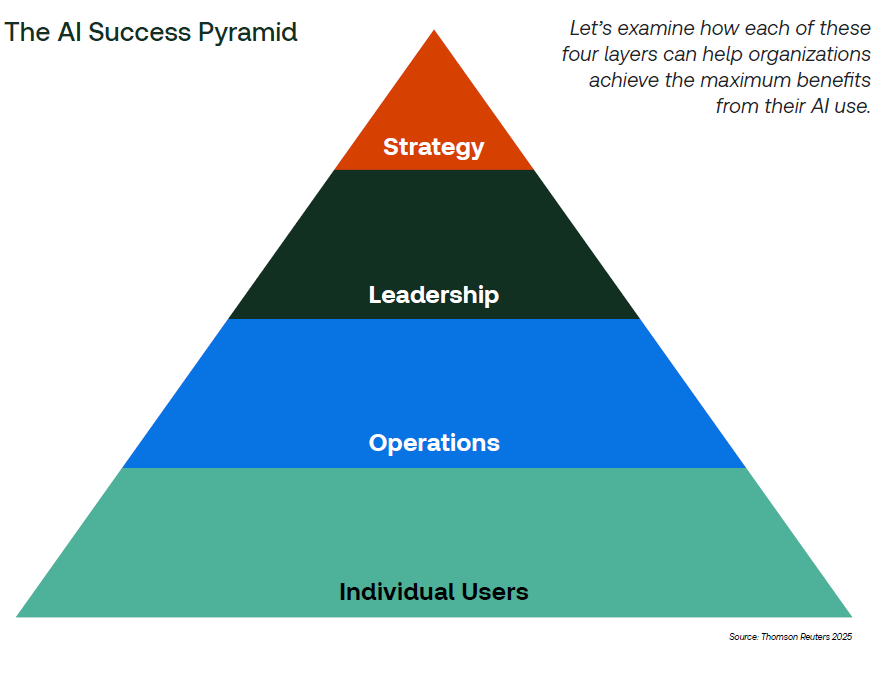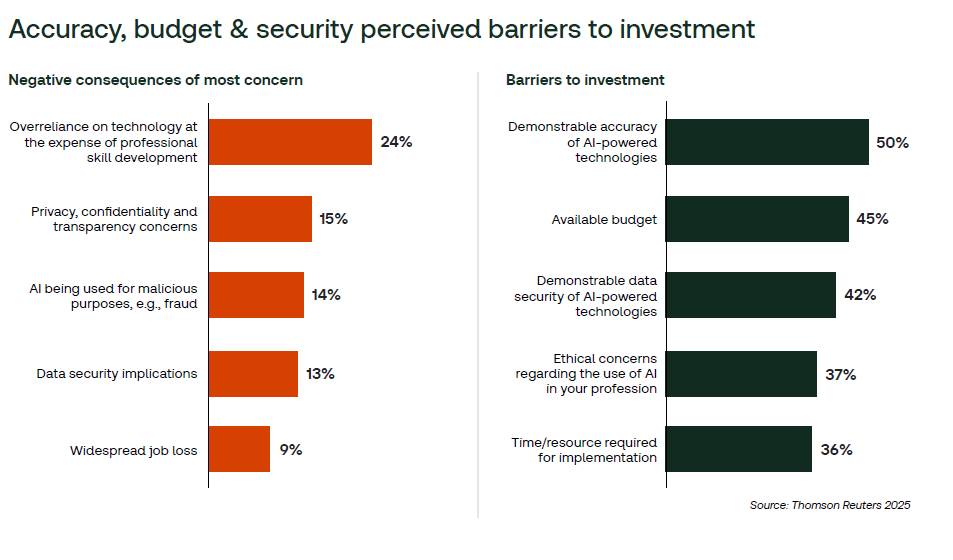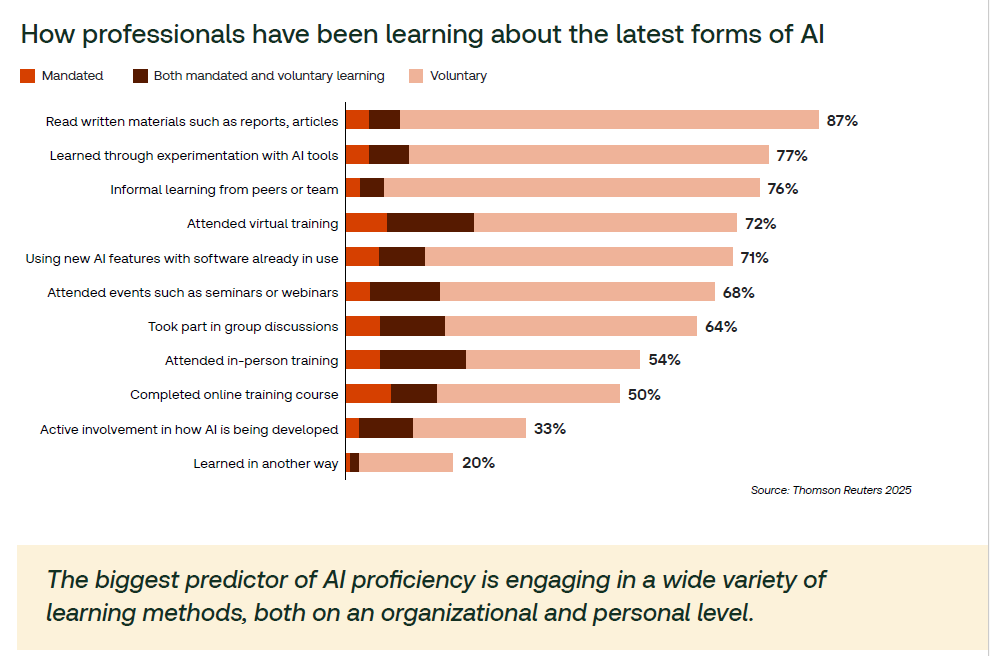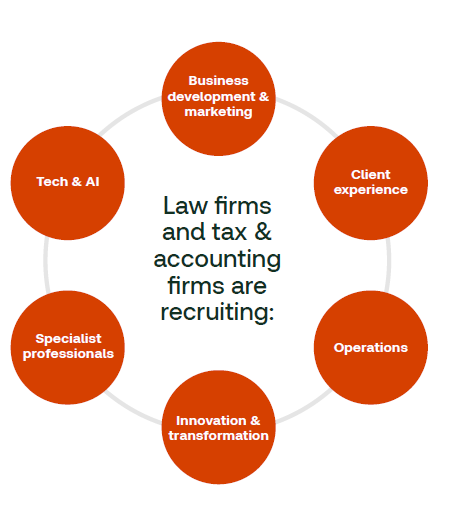The AI Divide: How Strategy Is Separating Winners from Losers in Law and Business
Thomson Reuters’ 2025 report shows how strategic AI adoption is redefining leadership across the legal and professional landscape
The Future Is Here, But Not Evenly Distributed
The 2025 Thomson Reuters report offers a sharp lens on how AI is redrawing the lines of professional success, especially in law, tax, compliance, and risk. AI is no longer a theoretical disruptor. It is a present-tense differentiator. The data shows measurable ROI and dramatic time savings, but only for those who approach it with intention.

Drawing on 2,275 responses across regions and sectors, the report outlines how professionals who align AI adoption with clear strategy are gaining ground. Those who don’t are falling behind, quickly. Specifically, the report suggests:
“The most successful organizations are those deploying AI within a coherent strategic framework — one that acknowledges today’s challenges while building resilience for tomorrow’s competitive landscape.”
The Strategic Divide
The core finding: organizations with a visible AI strategy are nearly twice as likely to report revenue growth. AI use is expected to save professionals an average of 240 hours annually by 2025, nearly $19,000 in value per person, contributing to a projected $32 billion annual impact in the U.S. legal and tax sectors.
The report underscores that the line isn’t between AI adopters and skeptics — it’s between those who use AI strategically and those who merely experiment.
The Four Layers of ROI
Thomson Reuters introduces a success pyramid built on four layers: Strategy, Leadership, Operations, and Individuals.
At the top is strategy, the strongest predictor of AI ROI. Firms with a visible, coherent AI plan are 3.5 times more likely to see returns and nearly twice as likely to experience revenue growth.
Leadership comes next. Leaders who model change, invest in AI tools, and evolve governance structures (like adding Chief Transformation Officers) create alignment. Culture follows behavior.
“In fact, those respondents who said their leaders were leading by example, were 1.7-times more likely to see the benefits of AI compared to those professionals who said their leaders were not leading by example.”
Operational change is where strategy meets execution. Leading firms are rethinking workflows, pricing, and services. Some are already offering AI-powered deliverables, while clients increasingly expect them.
Forward-looking firms are reevaluating whether their leadership structures match the demands of an AI-driven future. Many are moving beyond traditional, lawyer-only executive committees and introducing new roles, such as Chief Operating Officers and Chief Transformation Officers, to bring cross-functional insight and operational agility to the highest levels of decision-making.
At the base are individuals. Professionals with personal AI goals and regular hands-on experience are 2.4 times more likely to contribute to ROI. Adoption is cultural, not just technical.
Strategy without adoption is theater. Adoption without strategy is chaos.
The Jagged Edge of Adoption
Despite the momentum, adoption remains uneven. Only 46% of organizations invested in AI tools last year, and just 30% of professionals report regular use. Regions like Latin America show high use with low support. Others, like Europe, show the reverse, what the report calls “wasted investment.”
“High investment but low individual use suggests poor change management and wasted investment.”
Disparities within organizations are also sharp. Without coordinated planning, AI risks becoming a patchwork of ad hoc tools with no unifying vision.
What’s Holding Teams Back?
Accuracy concerns top the list. Ninety-one percent of professionals believe AI should meet higher accuracy standards than humans. Forty-one percent say they would only trust AI output if it were 100% accurate without human review, an unrealistic demand that reflects both optimism and fear.
Budget, data security, and ethical risks follow closely. Professionals also worry about overreliance. Some fear that offloading too much to AI will erode essential skills. The paradox: the tools that free us may also deskill us.
Yet, despite these concerns, skepticism around AI misuse or job loss has declined. The conversation is shifting from fear to caution, a sign of maturing understanding.
The Modern Professional
Today’s standout professionals combine subject-matter depth with AI fluency. They don’t replace core competencies like legal reasoning or strategic thinking, they enhance them with data, automation, and insight. More than that:
Our research shows that those professionals who fail to develop a personal strategy for AI proficiency will struggle to remain relevant and effective in their roles. And, as the demand for tech-savvy, adaptable and interdisciplinary collaboration continues to grow, those professionals not honing their skills in this way may find themselves adrift.
While the study broadly looks at all businesses, the message is clear for legal professionals as well. The competencies required to succeed are undergoing significant transformation. While foundational skills such as legal reasoning, strategic analysis, and persuasive communication remain essential, they are no longer sufficient on their own.
A new model of legal professionalism is emerging, one that integrates these traditional capabilities with technological fluency, particularly in the use of AI, to enhance analytical rigor, improve efficiency, and expand the capacity to deliver value in complex legal environments.
The report shows that 88% of professionals want AI tools customized to their field. Whether this becomes table stakes or a competitive edge remains to be seen, but fluency is fast becoming non-optional.
Still, 46% of professionals report skill gaps on their teams. Many cite weak digital literacy or poor understanding of how to apply AI in real workflows. Gen Z voices this frustration most loudly, while Gen X outpaces expectations in training uptake.
Rethinking the Team
Law firms and legal departments are no longer just hiring lawyers. They’re adding AI specialists, operations leads, innovation officers, and ESG strategists. The report confirms that the firms redefining roles and reconfiguring teams are the ones gaining ground.
But there’s another important concept that is missing from many law firms adoption of AI. As I’ve written previously, AI should not be treated like software, it should be treated like a junior team member. Like a bright but inexperienced associate, AI can take on tasks, suggest ideas, and accelerate output. But it needs oversight, context, and correction.
Firms that integrate AI into their workflows, governance, and service models see stronger innovation, better talent retention, and higher client satisfaction. They are not layering AI onto old systems. They are building around it.
The Final Word
Professionals and organizations have a choice: wait for AI’s impact to hit them, or wield it with purpose. The former may bring short-term comfort. The latter defines long-term advantage.
For lawyers, the message is clear. The firms that integrate AI into hiring, training, strategy, and service delivery will shape the next decade. Those who delay are already behind.
Contact the Author: Patrick T. Barone/Barone Defense Firm





